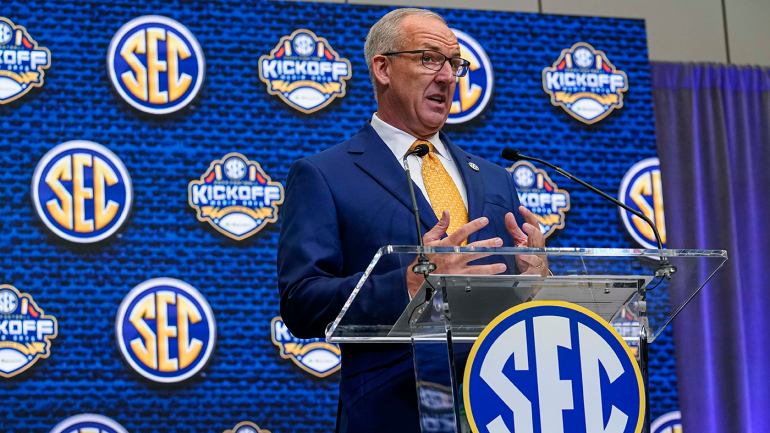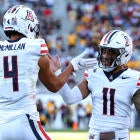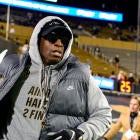
ATLANTA -- Greg Sankey spent a large part of his 2022 SEC Media Days state of the union address flexing. You probably didn't notice. It wasn't obvious to the naked eye because the SEC commissioner can be as subtle as a matching silk scarf, as vague as the rules of frisbee golf.
"There are likely others who would comment on that," Sankey told CBS Sports when asked whether his conference and the Big Ten have separated themselves from the rest of college football.
That's really what the game must consider most these days. It's not a formal separation of the SEC and Big Ten from everyone else, but it might as well be. The emergence of a Power Two from what used to be the Power Five is happening before our eyes. It commenced in earnest a year ago this week when word leaked at the 2021 edition of these media days that Texas and Oklahoma were joining the league.
A month before that revelation, Sankey had already told his league presidents it would be "the most consequential year in the history of college sports." Consider what has happened since: Alston v. NCAA decision; name, image and likeness rights; and the NCAA deciding to rewrite its constitution while ceding responsibilities to the membership power brokers like Sankey.
That was before the Big Ten ripped up the sod itself by inviting USC and UCLA into the fold. Everything changed that week and continues to shift to this day.
"We are a super league. … This is a super league," Sankey admitted Monday when asked directly if he would define the conference by that term.
He later added: "The Southeastern Conference is stronger now than at any other time in our history."
No surprise there. It's now just a question of how the SEC handles its added responsibilities. By 2025, when Texas and Oklahoma join, the SEC we will feature the greatest collection of football brands ever assembled this side of the NFL. Following closely behind -- or perhaps alongside the SEC -- will be the Big Ten.
The 32 teams comprising those conferences will be darn close to being able to stage their own playoff. They will have cornered most of the revenue and eyeballs that matter.
No one will ever accuse Sankey of being buddies with Big Ten commissioner Kevin Warren, but it will largely be up to them where college athletics heads.
"The reality is there will be two conferences at the FBS level with 16 teams that have competed consistently at the highest level," Sankey said. "That's a new dynamic."
The dynamic is revealing itself in stages. The job of conference commissioners is to make money for their leagues. That comes first in any discussion of higher learning related to athletics. What we're witnessing is that on steroids as TV rightsholders have basically decided to go all-in on those biggest brands.
The Big Ten reportedly wanted USC and Notre Dame before it settled for USC and UCLA. That was definitely in response to Texas and Oklahoma. Sankey basically said Monday what CBS Sports reported last week: The SEC prefers to stand pat at 16, but …
"… we'll watch what happens around us and be thoughtful but be nimble," Sankey said.
That's the silk scarf in the commissioner. His message: Don't try us. For the moment, Sankey has tacitly removed the SEC's support of a 12-team playoff that includes six spots reserved for the top-ranked conference champions.
"I'd be fine with no [automatic qualifiers]," he said.
That's code for opening the field to as many SEC teams as possible. If Notre Dame goes to the Big Ten, it may not matter to the SEC. Sankey's conference won't mess with possible ACC desirables Clemson, Florida State and Miami -- until and unless those schools find a way to extricate themselves from a stifling grant of rights. Maybe not even then.
Sankey won't say that out loud, but it's obvious: With realignment still roiling, it is in the Power Two's best interest that there be one less FBS conference. Less competition for playoff spots and playoff revenue for starters.
"I don't view those as absolutes," Sankey told CBS Sports.
But they might be inevitabilities. Last year, it was the Big 12 that almost went away. This year, it might be the Pac-12. There are responsibilities -- added responsibilities going forward. Sankey said he noticed at the conference's spring meetings when someone had tweeted out the coaches' seating chart at their Destin, Florida, resort.
"It is never going to be the same, but it doesn't have to be the way that it is," he said Monday. "We're dealing with complex problems that won't be solved by complaints, by accusations, by finger pointing or by offering simple solutions."
It's possible the issues are too big to be solved. Sankey was reminded that many of his administrative peers are resigned to a future that includes a professional model complete with revenue sharing and collective bargaining. Those are things Sankey, a strict traditionalist coming up as Mike Slive's No. 2, might have fought. Now, he is resigned to some of it.
"I think we have to be attentive to it … instead of opining," Sankey said.
It's all moving so fast, maybe too fast. Missouri in the SEC and Nebraska in the Big Ten have completely lost the foundation of cultures developed in the Big Eight/Big 12. Yeah, but the money spends, and that's why they left, right?
Remember that dynamic.
Lane Kiffin may have offered the wisest view Monday. There's an actual football angle to all this. The super league is ready to squash everybody on the field, too.
"You may have had it better than you thought," Ole Miss' coach said of the Texas-Oklahoma migration. "I've always said the SEC is not for everybody. I never thought about teams. For coaches, I've seen it just tear people up. If you're not wired a certain way, you don't work in the SEC, and it just spits you out."
Consider the Longhorns and Sooners won't enter the SEC until 2025, yet they're already plotting against the current Big 12 powers in the Strength Everywhere Conference.
But why stop there? There are worlds to conquer. Monday's message endures: This is the strongest the league has ever been.
"This doesn't seem right, Texas and Oklahoma going to the SEC," Kiffin added, "but USC and UCLA going to the Big Ten seems wrong."





















